Ecommerce Sizing Technology: How Wearable Brands Help Customers Find the Right Fit
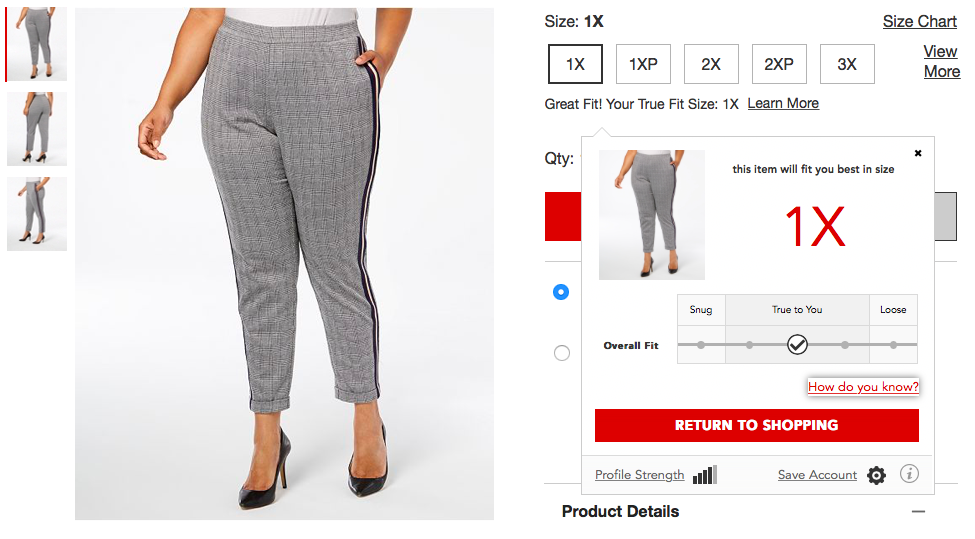
If you remember one thing about ecommerce sizing technology, let it be this: helping online shoppers find the perfect fit is the ultimate in retail personalization. Sizing technology is an opportunity to reflect retail’s broader transformation, as stores no longer offer the same experience to all. Now by finding–and saving for the future–the right fit, the shopper can forever have her own tailored experience.
Online clothing sales currently have a 20-40% return rate, and a whopping 77% of shoppers say they have returned a purchase due to poor fit. Additionally, 58% say they would buy more clothes online if they could be assured of fit. So how can online retailers use sizing technology to reduce returns and increase sales? Let’s take a look.
Virtusize

Virtusize is a sizing software program used by many brands like Nudie Jeans. The sizing company was founded by a group of fashionista friends in Sweden who wanted to buy clothes from around the world, but kept getting the wrong sizes. Virtusize works from the idea that we all have our favorite clothes that fit just right.
When I clicked on the virtual size guide, circled in yellow above, a pop-up appeared: “Compare these trousers to trousers that you already own.” I went and got out a pair of jeggings (jean leggings – weird word, I know) that I bought in Italy last year.
The program then walked me through a series of measurements: waist, hip, back rise, front rise, and more. Most importantly, it showed me WHERE to take these measurements. I have only a vague sense of where the back rise is. But Virtusize illustrated exactly where to place my measuring tape, so I could get the precise number. The final result looked like this:
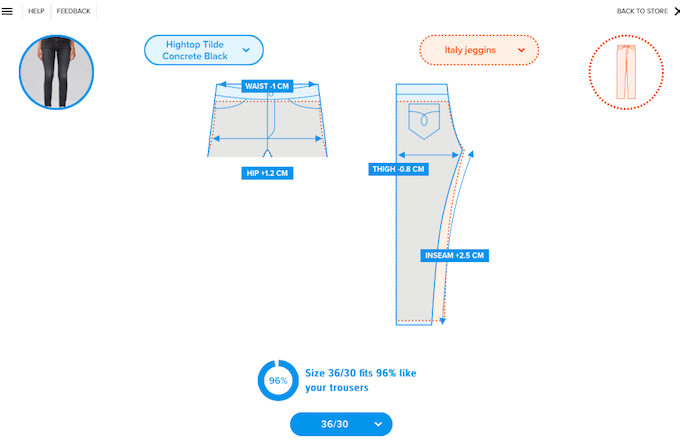
Now I know that if I buy a pair of Hightop Tilde jeans in size 36/30 they will fit very closely (96%) to my favorite pair from Italy. The size will differ in the inseam, and this makes sense. My jeggings fit closely through the calf and ankle, like leggings. But I’m buying jeans, so the fit will be looser in that area.
Note that I did not have to register or set up an account to get my sizing information. However, after Nudie Jeans showed me my best fit, I was prompted to save the info and set up an account on Virtusize. Many retailers are adopting this technology, so I did it.
Added bonus: once I’ve bought my Nudie Jeans, I can use my jeans as a new garment for comparison on other sites that use Virtusize. As the company explains, “Shoppers can find items they have bought from stores connected to Virtusize right in the widget. Clicking on the Compare button for a previous purchase makes Virtusize show a comparison between that and the item shoppers are looking to buy.
The Third Love Fit Finder
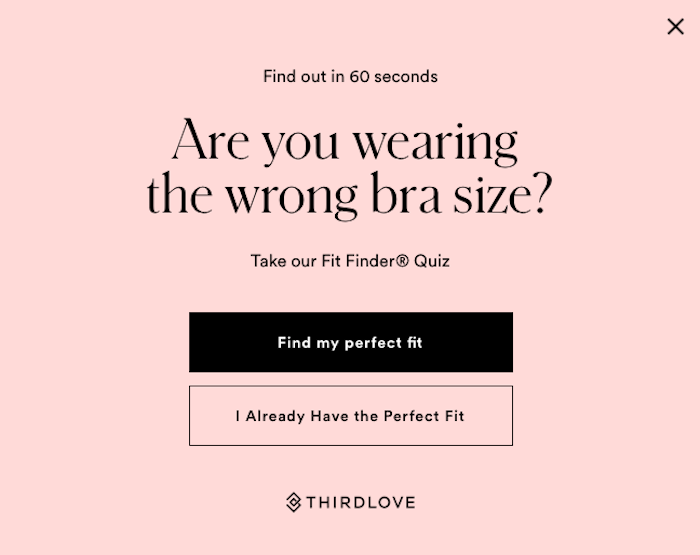
Bras are notoriously hard to fit, and intimates retailer Third Love wants to help women overcome this issue.
Similar to Virtusize, the survey begins by asking me about my favorite everyday bra now. (Disclaimer: we’re talking about ecommerce personalization, but I’m not going to get too personal with this!) The survey includes current cup size, band size, overall height, and even cup shape. After I answer all the questions, but before I can see the results, Third Love asks me to submit my email address. The site then provides me with their sizing suggestion:
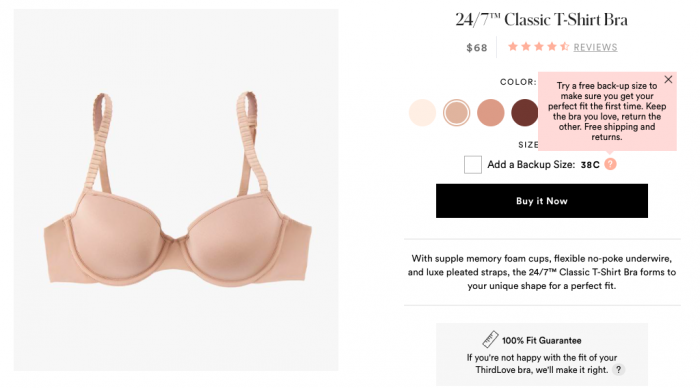 There were a couple of things I really like about this experience: First, they quickly show me a primary suggestion (this is covered up by the pink pop-up above.) AND then, as the pop-up says, they will also send along a free back-up size to ensure the perfect fit. How cool is that?
There were a couple of things I really like about this experience: First, they quickly show me a primary suggestion (this is covered up by the pink pop-up above.) AND then, as the pop-up says, they will also send along a free back-up size to ensure the perfect fit. How cool is that?
Secondly, now that they have my email, I’m getting Third Love promos. In the emails, when I click on a bra that interests me, I’m instantly directed to a product page with my size selected. It’s a really nice feeling that they remember me, and now we’re building this relationship. I love it.
True Fit
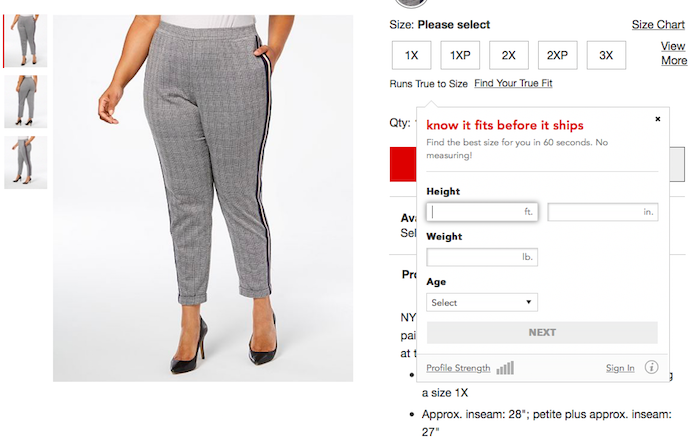
In the company’s own words, “True Fit knows what fits by comparing data from thousands of the world’s best brands to the clothes and shoes you tell us fit you best. Plus, True Fit gets smarter as we learn more about what fits you and what types of clothes and shoes you love!” The sizing technology is used by many retailers, including Macy’s as shown in the example above.
When I click on the link, Find Your True Fit, the pop-up appears with simple questions: height, weight, and age. Once I fill out these things, I’m asked about my favorite pair of jeans–size, inseam, and cut. Then after only two, quick pop-ups, they recommend the best size:
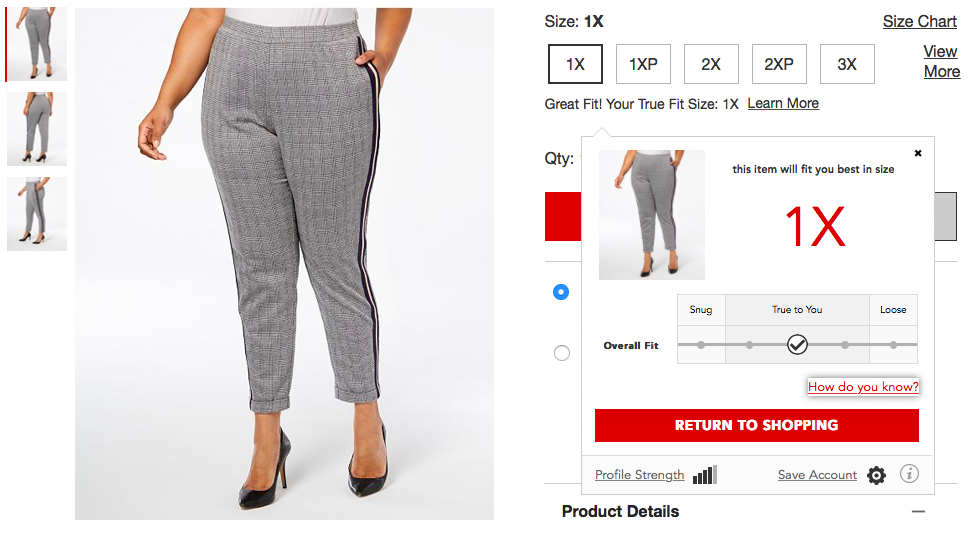
Finally, if I click on the link to save my size information, I can then access it on any site that uses True Fit. Nice.
Acustom Apparel 3D Technology
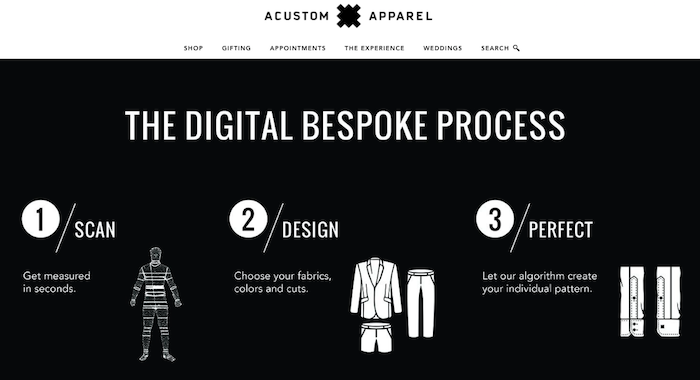
We can’t talk about ecommerce sizing technology without bringing up 3D modeling. Over at Shopify, Daniel Beauchamp, Head of AR/VR is working on this all the time. In our interview with Daniel, he talked about a body suit that shoppers can put on at home to take their measurements in 3D with their phone. But that has a lot of friction to it, no?
For this article, I tried an app that promotes itself as being able to help shoppers measure their own sizing in 3D. Through brief video clips, the app gave me instructions on how to measure every area of my body using my iPhone. But it was so sensitive that I kept having to re-measure. And in the end, the app still asked me, “which of these brands do you wear and in what size?”. It felt like a lot of work to get to the same place that Virtusize and True Fit arrive at easily.
But let’s keep in mind that last year Amazon paid approximately $70 million for a company called BodyLabs. This company has a deep experience in modeling the human body in 3D. In time, Amazon will likely use this technology to improve sizing for their wearable products. Yet, as I like to encourage retailers, there are ways to get some of Amazon’s benefits while using different technology.
In thinking of smaller scale retailers using 3D body technology, the men’s retailer, Acustom Apparel, is nailing it. They have a proprietary process where shoppers receive a private digital body scan in their physical store. In this measuring process, they gather 2,000,000 data points about the customer’s size! From there, the shopper works with a personal stylist to customize their clothing. Everything is sure to fit brilliantly.
The retail industry is right on the cusp of employing 3D models for the perfect fit. Yet brands like Acustom Apparel are answering this customer need now.
In conclusion
Some retailers, particularly large online department stores, still list Petite and Plus sizes under the category of “Special Sizes.” I beg to differ. There are not normal versus abnormal sizes. (Vanity sizing, I’m talking to you.) People aren’t too small or too large–we are all simply our own size.
The emerging technology behind ecommerce sizing holds the potential to offer much greater customization for online clothes shopping. As a result, everyone wins. Shoppers find the perfect fit and keep returning to purchase more of the clothing that works for their bodies. And retailers reduce product returns, while creating deeper connections with their customers for the long-term.
